User:TheVirginiaHistorian/sandbox/History of Virginia on stamps
History of Virginia on stamps
The history of Virginia has been celebrated on stamps accounting for many important events and personalities of the nation's history.
Events and eras[edit]
Jamestown and settlement[edit]
The Jamestown Centennial series featured John Smith, Jamestown Settlement and Pocahontas. Jamestown was the first permanent English settlement in the New World. John Smith as governor ended the "Starving Time" with his dictum, "He that will not work, shall not eat."[1] Pocahontas was instrumental in the colony's survival when she married John Rolfe of tobacco fame, bringing peaceful relations with the neighboring Powhatan tribes during her lifetime.[2]
 1907 issue |  1907 issue |  reissue |
Important Virginia colonial women included Virginia Dare, first born English child at Roanoke, the lost colony.[3] Widow Martha Custis married George Washington enhancing his status as a colonial gentleman, from which he launched his public career.[4]
 Virginia Dare 1937 issue |  Martha Washington 1938 issue |
Daniel Boone was honored with a 6-cent stamp in the American Folklore Series on September 26, 1968, at Frankfort, Kentucky, where he was buried. He was a famous frontiersman in the development of Virginia, Kentucky and the trans-Appalachian west. A wall of roughly-hews boards display the tools of Boone's trade—a Pennsylvania rifle, a powder horn, and a knife. The pipe tomahawk represents that the Shawnees had adopted Boone. His name and birth date was carved on the wall.[5]
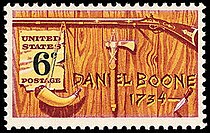 Virginia Dare 1968 issue |
Revolution and New Nation[edit]
- Revolution
Patrick Henry was a leader in the Virginia House of Burgesses who opposed Britain imposing restrictions on the American colonies. Virginia petitioned the King and Parliament for redress without success. Following his attending the First Continental Congress, Henry's resolves in the second Virginia Convention were published in the Virginia Gazette and widely reprinted in other colonial papers, influencing other colonial legislatures.[6]
 1955 issue |  1977 issue |  1973 issue |
The signing of the Declaration of Independence was commemorated with a 24-cent stamp in 1869. The stamp depicts John Trumbull’s painting in the U.S. Capitol rotunda. The stamp image is 1/300th of the original. The National Bank Note Company printed 235,350 stamps of this 24-cent issue.[7] In the Second Continental Congress, George Washington was unanimously elected to lead the Continental Army besieging Boston. He personally commanded campaigns in the north.[8]
 1869 issue |  General George Washington 1932 issue |
Washington saving his army at Brooklyn was commemorated on a 3-cent stamp at the 175th anniversary on December 10, 1951. The vignette shows Washington directing troops at Fulton Ferry house. Troops in the background are seen crossing the East River.[9]
Major George Rogers Clark commanded Virginia rangers capturing Vincennes in the western theater.[10]
The climatic battle of the Revolutionary War was the Battle of Yorktown which led to the Treaty of Paris (1783) recognizing U.S. independence by Great Britain. Washington was assisted by French troops under General Rochambeau, guns and a French naval victory under Admiral DeGrasse.[11]
 1951 issue |  Major George Rogers Clark 1929 issue |  Yorktown 1931 issue |
- Constitution and beginnings
The first written U.S. constitution was the Articles of Confederation. Under the Articles, Virginia ceded its claim to territory north of the Ohio River to the United States Government to form the Northwest Territory. There was no independent executive branch or judicial branch, only Congress. The Constitution of the United States was written in an effort to form a more effective national government, with George Washington elected unanimously to be the president of the Constitutional Convention. In 1789, Washington was sworn in as the first President of the U.S., having been elected unanimously by the Electoral College.
 1977 issue |  1937 issue |  1838 issue |
Four of the first five presidents were from Virginia. George Washington was the first, the "Father of his country". He was followed by his Vice President John Adams.
 1939 issue |
- The Virginia Dynasty
Then for six presidential terms in a row, "The Virginia Dynasty" governed the U.S. with three successive presidents of two terms each: Thomas Jefferson, the author of the Declaration of Independence, James Madison the father of the Constitution and James Monroe, president of the Monroe Doctrine negotiated by John Quincy Adams as his Secretary of State.
 Thomas Jefferson 1856 issue |  James Madison 1903 issue |  James Monroe 1904 issue |
Growth of the Nation[edit]
Virginia played important roles in the growth of the United States, both by ceding territory and a new state to the nation, and by providing leadership and out-migrant population moving west.
- Early growth
Following the Peace of Paris, the U.S. grew internally, first by territories that would become states in the Ordinance of 1787. With the new Constitution, Virginia petitioned Congress to admit Kentucky from its western territory as a separate state to the Union in 1792.[12]
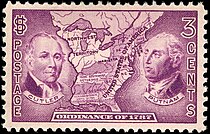 1937 issue |  1942 issue |
- Louisiana Purchase
James Monroe was one of the negotiators in Paris for the Louisiana Purchase, which doubled U.S. Territory under the presidency of Thomas Jefferson. Madison made Monroe his Secretary of State.[13] Meriwether Lewis and William Clark explored the Purchase Territory and west to the Pacific Ocean on the Lewis and Clark Expedition.[14]
 1953 issue | 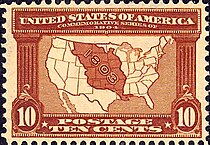 1903 issue |  1954 issue |
- Westward migration
Virginia was not only the mother of presidents, it was the mother of states by its large out-migration in the first half of the nineteenth century. Although a majority of Virginia out-migration was to western border and northern states, both Texas leaders Sam Houston and Stephen Austin were from Virginia.[15]
 1898 issue |  1936 issue |
- Mexican American War
Winfield Scott was the U.S. hero of the Mexican American War, conquering Mexico City. He recommended Virginia born Zachary Taylor from Kentucky for command of the northern U.S. army.[16] Territory added to the nation was called the Mexican Cession, filling out the U.S. manifest destiny to occupy the North American continent from the Atlantic to the Pacific, from "sea to shining sea".[17]
Pictured alongside Scott in this 1937 issue is the "Hero of New Orleans" from the War of 1812 during James Madison's administration, Andrew Jackson.
 1964 issue |
Civil War[edit]
The senior commander of the U.S. army at the onset of the American Civil War was Winfield Scott, author of the Anaconda Plan (seen in commemorative above). Union admirals included David Farragut. Union General George Henry Thomas achieved fame in the west as the "Rock of Chickamauga". Opposing were fellow Virginians, Generals Robert E. Lee and Thomas Jonathan Jackson. General J.E.B. Stuart won fame as a cavalry commander.
 1965 issue |  1937 issue |
Virginia was a major battlefield of repeated campaigns between Washington D.C. and the Confederate capital at Richmond, including Battle of First Bull Run in 1861, the 1862 naval ironclad Battle of Hampton Roads, Jackson's Valley Campaign, McClellan's Peninsula Campaign, Battle of Second Bull Run, Battle of Fredericksburg, the 1863 Battle of Chancellorsville, the 1864 Overland Campaign in the Virginia Wilderness and the Siege of Petersburg, and in 1865, "The Surrender" of Lee's army at Appomattox.
 First Bull Run 2011 issue |  Wilderness campaign 1965 issue |  The Surrender 1964 issue |
For additional USPS images, see links to Smithsonian Institute's "Arago: people, postage & the post" online at Monitor and Virginia stamp and the Chancellorsville stamp.
West Virginia became a state following the Wheeling Conventions. Fifty northwestern counties of Virginia whose population had been underrepresented in the General Assembly were successfully admitted to the Union as a new state on June 20, 1863.
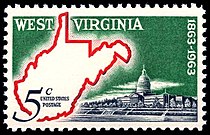 West Virginia statehood 1963 issue |
World Wars[edit]
In World War I, training facilities were set up in Virginia, shipbuilding expanded and the Hampton Roads served at a port of embarkation. Virginia-born President Wilson was the war president for World War I.
 Victory and allied flags, 1917 issue |
In World War II, the Hampton Roads served as a major embarkation port for troops shipping over to the European Theater of Operations. During the war several bases were established and expanded for training, including Fort Pickett outside Fredericksburg and Fort Lee outside Petersburg. The Marine Base at Quantico, Virginia was expanded from its World War I beginnings as the training center for all Marine officers. A replica of the Iwo Jima Memorial is at its main gate today. Virginia National Guard Army units made up part of the 29th Infantry Division which landed on D-day at the Normandy beaches and fought through to Germany in World War II.
 1946 issue |  1945 issue |  1945 issue |
Recent Virginia[edit]
Virginia has a nuclear power plant at Surry and at North Anna. Shipbuilding in the Hampton Roads continues to be a major industry. The Norfolk Navy Base is one of the largest in the world.
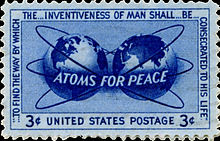 1955 issue |  1957 issue |  1957 issue |
Famous Virginians[edit]
Virginians gained fame in careers away from Virginia, including Texas statesman Sam Houston, Tuskegee University educator Booker T. Washington, and army doctor Walter Reed.
 1963 issue |  1940 issue |  1940 issue |
At least two Virginians became famous as explorers and are commemorated on stamps.
Daniel Boone was honored with a 6-cent stamp in the American Folklore Series on September 26, 1968, at Frankfort, Kentucky, where he was buried. He was a famous frontiersman in the development of Virginia, Kentucky and the trans-Appalachian west. A wall of roughly-hews boards display the tools of Boone's trade—a Pennsylvania rifle, a powder horn, and a knife. The pipe tomahawk represents that the Shawnees had adopted Boone. His name and birth date was carved on the wall.[18]
Richard E. Byrd's Byrd Antarctic Expedition II stamp was commemorated on a 3-cent stamp the same size and shape as Special Delivery on September 22, 1933. Intended for the collectors' market alone, the 'philatelic mail' with this stamp was carried by the expedition and postmarked at the Little America post office, the expedition's base camp.[19]
 1968 issue |  1933 issue |
Big ideas and landmarks[edit]
The Thomas Jefferson Memorial was commemorated with a 10-cent regular stamp issued on December 14, 1973. The stamp features the introductory phrase to the Declaration of Independence, “We hold these truths…” authored by Jefferson. The neoclassical building was dedicated to the third president of the United States in 1943. It hosts annual Memorial events, Easter Sunrise Services, and the Cherry Blossom Festival. .[20] Thomas Jefferson authored the Virginia Statute of Religious Freedom which disestablished the Anglican Church in Virginia. Here religious freedom is commemorated at the earlier Flushing Remonstrance.
 1973 issue |  1960 issue |
The American Credo commemorative series featured three Virginian's quotes.
- "Give me liberty or give me death" -- Patrick Henry.
- "I have sworn … hostility against every form of ‘’tyranny’’ over the mind of man." -- Thomas Jefferson.
- "Observe good faith and justice towards all nations." -- George Washington.
 Liberty or death - P. Henry 1960 issue |  I have sworn hostility -Th. Jefferson 1960 issue |  Observe good faith - G. Washington 1960 issue |
Stamps commemorating Virginia events and landmarks include Mount Vernon, and Stratford Hall
 Mount Vernon 1936 issue |  1958 issue |  Stratford Hall 1936 issue |
Stamps commemorating Virginia events and landmarks include the Old Court House in Williamsburg, Monticello outside Charlottesville, and Carlyle House, Gadsby's Tavern in Alexandria, and Arlington National Cemetery in Arlington.
 1938 issue |  Monticello 1956 issue |  Alexandria old town 1949 issue |
 Arlington Cemetery, 1938 issue |  1956 issue |  1948 issue |
The Virginia colonial capitol building at Williamsburg is pictured in the 1988 USPS stamp commemorating the bicentennial of the ratification of the Constitution, which is available for viewing at Virginia ratification stamp from "Arago: people, postage & the post", online at the Smithsonian Institute's National Postal Museum.
Virginia's Presidents[edit]
Eight U.S. presidents have been born in Virginia. Besides those born and raised and elected from Virginia, presidents born in Virginia made their careers in other states, William Henry Harrison in Indiana, Zachary Taylor, Woodrow Wilson in New Jersey.
Sam Houston made his home in Texas where he became president of the Republic of Texas. Joseph Jenkins Roberts was the first president of the Republic of Liberia.
- George Washington
 George Washington 1847 issue |  George Washington CSA 1861 issue |  George Washington 1903 issue |  George Washington 1938 issue |
- Thomas Jefferson
 Thomas Jefferson 1856 issue |  Thomas Jefferson CSA 1862 issue | 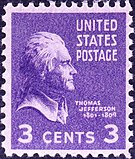 Thomas Jefferson 1938 issue |  Thomas Jefferson 1968 issue |
- James Madison
 James Madison 1903 issue |  James Madison 1894 issue |  James Madison 1938 issue |
- James Monroe
 James Monroe 1904 issue |  James Monroe 1938 issue |  James Monroe 1954 issue |  James Monroe 1958 issue |
- William Henry Harrison
 William Henry Harrison 1950 issue |  William Henry Harrison 1938 issue |  William Henry Harrison 1903 issue |
- John Tyler and Zachary Taylor
 John Tyler 1938 issue | 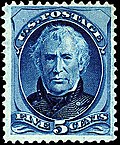 Zachary Taylor 1875 issue |  Zachary Taylor 1938 issue |
- Woodrow Wilson
 Woodrow Wilson 1925 issue |  Woodrow Wilson 1938 issue |
See also[edit]
References[edit]
- ^ Wallenstein, Peter. op.cit., p. 17.
- ^ Wallenstein, Peter. op.cit., p. 19-20.
- ^ Wallenstein, Peter. op.cit., p. 10.
- ^ Wallenstein, Peter. op.cit., p. 59.
- ^ “1968 American Folklore Issue”, Arago: people, postage & the post, National Postal Museum online, viewed March 16, 2014.
- ^ Wallenstein, Peter. op.cit., p. 70-71.
- ^ Haimann, Alexander T., “24-cent Signing of the Declaration of Indpendence”, Arago: people, postage & the post, National Postal Museum online, viewed March 24, 2014.
- ^ Wallenstein, Peter. op.cit., p. 76-77.
- ^ ”175th Anniversary of Battle of Brooklyn Issue”, Arago: people, postage & the post online, National Postal Museum. Viewed April 15, 20014.
- ^ Wallenstein, Peter. op.cit., p. 74.
- ^ Wallenstein, Peter. op.cit., p. 80.
- ^ Wallenstein, Peter. op. cit., p. 107.
- ^ "Monroe, James", Webster's Guide to American History. 1971. G. & C. Merriam Company Publishers. SBN 87779-081-7 pp. 1130.
- ^ Wallenstein, Peter. op. cit., p. 110-111.
- ^ Wallenstein, Peter. Cradle of America: four centuries of Virginia history. 2007, ISBN 978-0700615070. p. 123.
- ^ "Scott, Winfield", Webster's Guide to American History. 1971. op. cit., pp.1220
- ^ "Canada and Mexico", Webster's Guide to American History. 1971. op. cit., p. 672.
- ^ “1968 American Folklore Issue”, Arago: people, postage & the post, National Postal Museum online, viewed March 16, 2014.
- ^ Lawson, Mary H.,”Byrd Antarctic Issue”, Arago: people, postage & the post, National Postal Museum. Viewed March 22, 2014.
- ^ ”Jefferson Memorial Issue”, Arago: people, postage & the post, National Postal Museum. Viewed March 18, 2014.
Bibliography[edit]
- Dabney, Virginius. Virginia: the new dominion, a history from 1607 to the present 1989. ISBN 978-0-813-91015-4.
- Heinemann, Ronald L., et.al., Old Dominion, new commonwealth: a history of Virginia, 1607-2007 2008. ISBN 978-0-813-92769-5.
- Wallenstein, Peter. Cradle of America: four centuries of Virginia history 2007. ISBN 978-0-700-61507-0.
